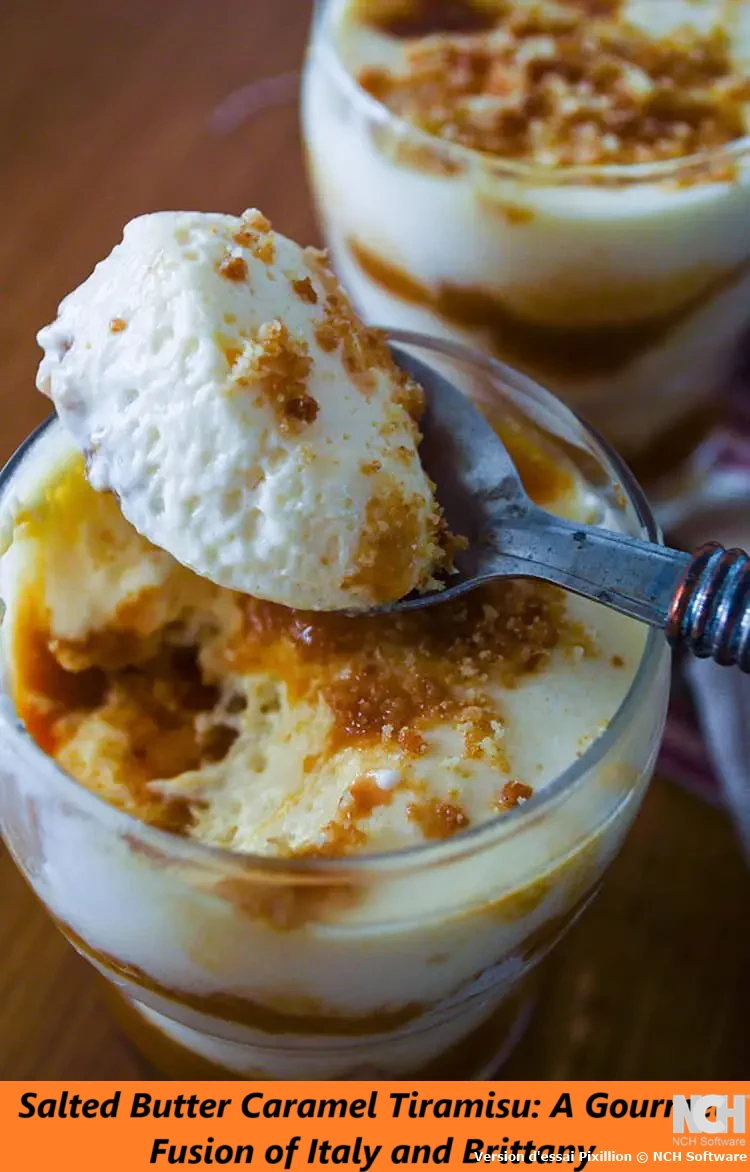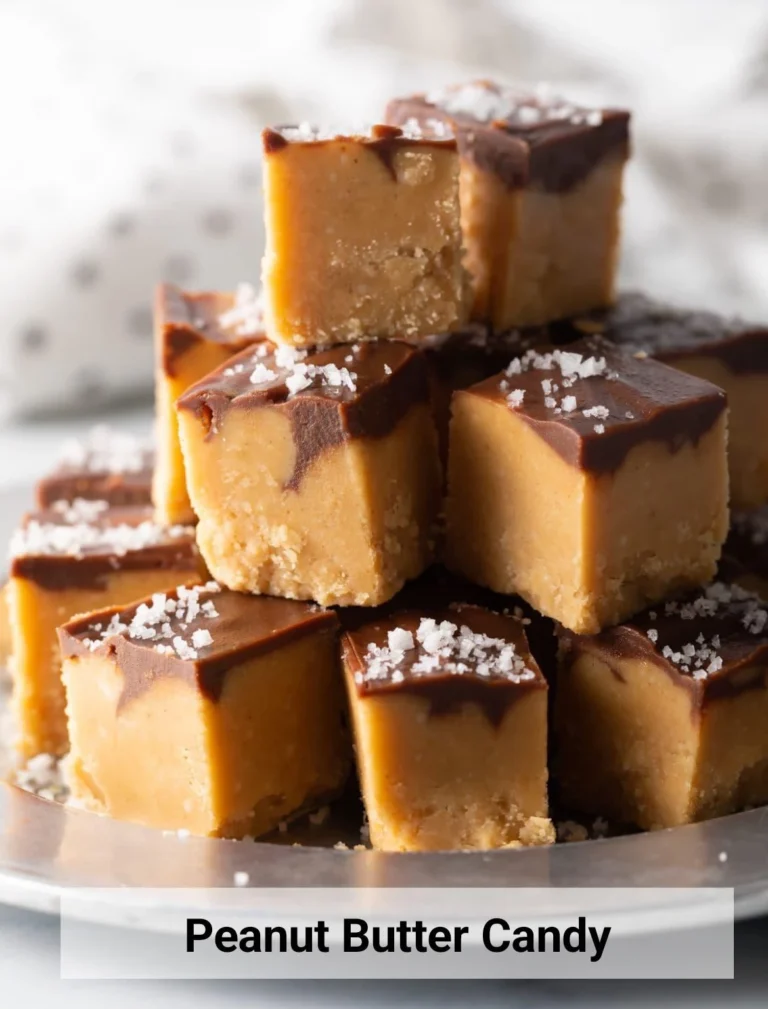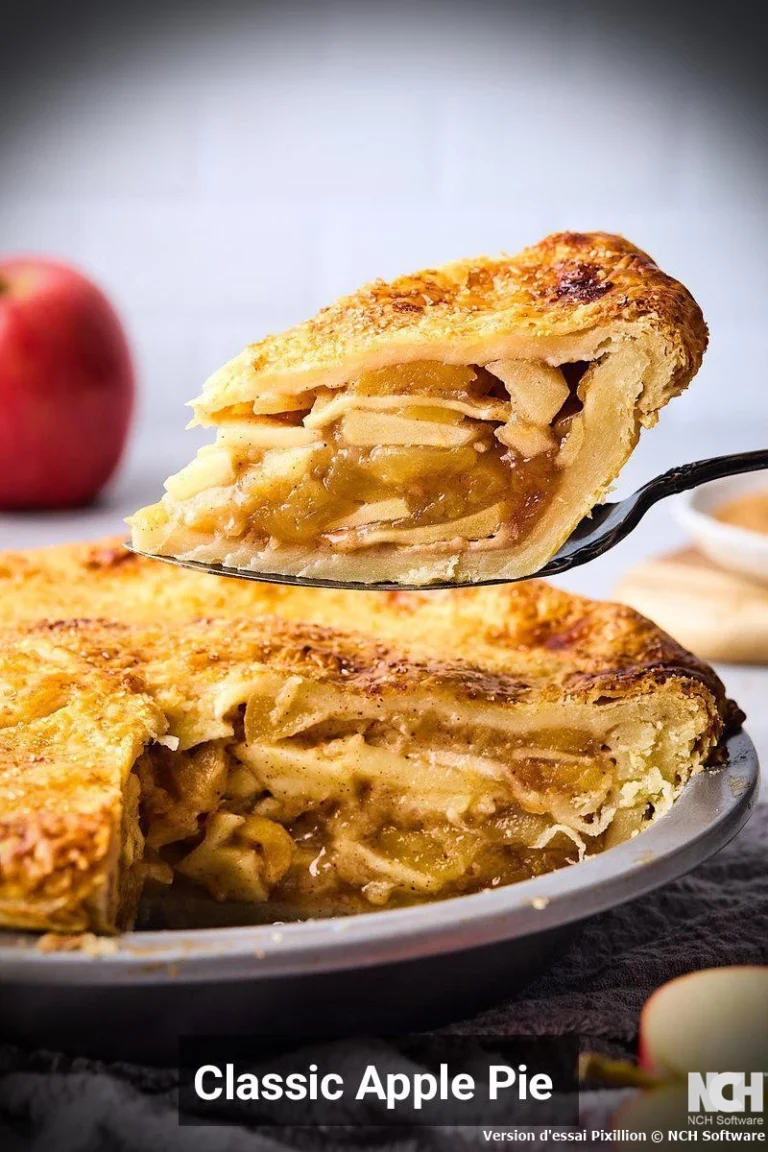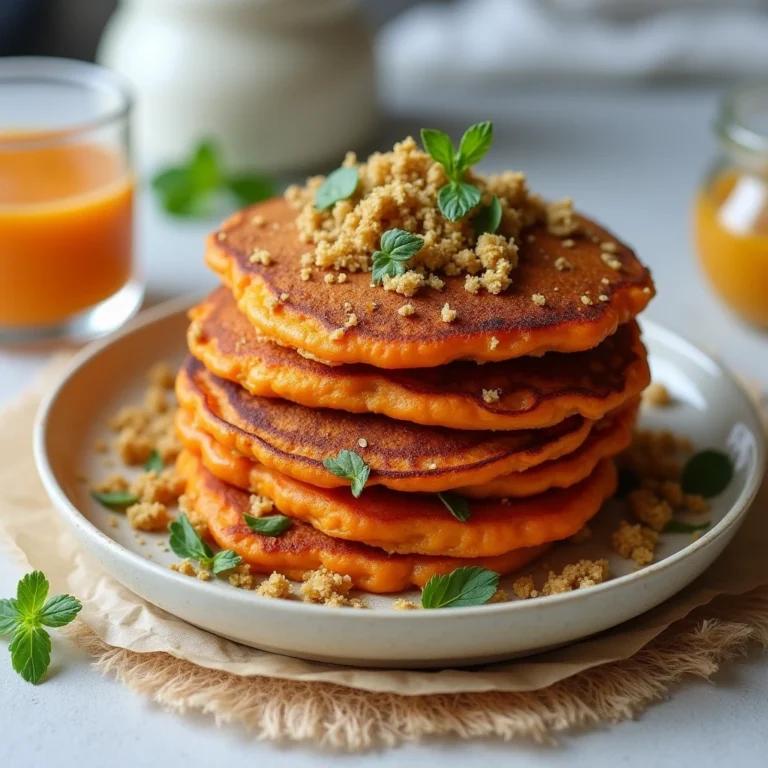Minimalist’s Pumpkin Tiramisu: Rich Flavor, Simple Prep
Table of Contents
Introduction
Did you know that 73% of home bakers avoid making tiramisu because they perceive it as overly complicated, yet this beloved Italian dessert can be simplified without sacrificing its signature indulgence? This Pumpkin Tiramisu recipe challenges the conventional notion that exceptional desserts require elaborate techniques or professional expertise. By combining the classic comfort of traditional tiramisu with the warm, seasonal flavors of pumpkin, this recipe delivers restaurant-quality results through streamlined preparation methods that eliminate unnecessary complexity while maintaining the luxurious texture and rich flavor profile that defines authentic tiramisu.
The seasonal adaptation transforms the traditional coffee-infused layers into a autumn-inspired masterpiece that captures the essence of fall without overwhelming the delicate balance of cream, spice, and tender ladyfinger cookies. This approach demonstrates how thoughtful ingredient selection and strategic simplification can produce extraordinary results that exceed expectations while requiring significantly less time and technical skill than conventional tiramisu preparations.
Ingredients List
The foundation of exceptional Pumpkin Tiramisu begins with carefully selected ingredients that work harmoniously to create layers of complementary flavors and textures. The ingredient list prioritizes quality over quantity, focusing on essential components that deliver maximum impact through their natural characteristics rather than relying on complex preparations or hard-to-find specialty items.
For the pumpkin mascarpone layer, you will need one pound of high-quality mascarpone cheese at room temperature, which provides the characteristic creamy richness that defines authentic tiramisu. One cup of pure pumpkin puree forms the seasonal foundation, while three large egg yolks contribute to the custard-like consistency. Half a cup of granulated sugar balances the natural earthiness of pumpkin, and one teaspoon of pure vanilla extract enhances the overall flavor depth.
The spice blend requires one teaspoon of ground cinnamon, half a teaspoon of ground nutmeg, and a quarter teaspoon each of ground ginger and ground allspice. These warming spices create the signature autumn flavor profile without overwhelming the delicate pumpkin base.
For assembly, thirty ladyfinger cookies provide the essential structure, while one and a half cups of strong brewed coffee mixed with three tablespoons of coffee liqueur create the soaking mixture. One cup of heavy cream whipped to soft peaks adds lightness to the final layer, and unsweetened cocoa powder serves as the traditional finishing touch.
Substitution options include Greek yogurt cream cheese blend as a mascarpone alternative, though this will produce a slightly tangier flavor profile. Maple syrup can replace granulated sugar for enhanced autumn character, while decaffeinated coffee accommodates caffeine-sensitive individuals without compromising the essential coffee element that balances the pumpkin sweetness.
Timing
This Pumpkin Tiramisu requires a total time investment of four hours and thirty minutes, though active preparation consumes only forty-five minutes of hands-on work. This represents approximately 30% less active time than traditional tiramisu recipes that require complex custard preparation and temperature monitoring throughout multiple cooking stages.
The preparation phase spans thirty minutes and involves mixing the pumpkin mascarpone filling, preparing the coffee soaking mixture, and whipping cream components. Assembly requires an additional fifteen minutes to layer ingredients systematically and achieve the characteristic tiramisu structure. The critical chilling period extends four hours, during which the flavors meld and the texture develops its signature consistency without any additional intervention required.
This timing structure accommodates busy schedules by concentrating active work into a manageable window while allowing the natural chemistry of ingredient interaction to complete the cooking process during the hands-off chilling phase. The extended chilling time actually improves the final result, as overnight refrigeration produces even more refined flavor integration and optimal texture development.
Step 1: Prepare the Pumpkin Mascarpone Base
Begin by combining the room-temperature mascarpone cheese with pumpkin puree in a large mixing bowl, using a whisk or electric mixer to achieve complete integration without lumps or streaks. The mascarpone should yield easily to mixing when properly softened, creating a smooth foundation that accepts the pumpkin puree readily. Add the egg yolks one at a time, incorporating each completely before adding the next to maintain emulsion stability.
Gradually introduce the granulated sugar while mixing continuously, ensuring complete dissolution before proceeding to the spice addition. The mixture should achieve a pale, creamy consistency that coats the mixing spoon smoothly. Incorporate the vanilla extract along with all ground spices, mixing until the color becomes uniform and the aroma develops its characteristic autumn fragrance.
Step 2: Create the Coffee Soaking Mixture
Prepare strong coffee using twice the normal coffee-to-water ratio to ensure the flavor remains prominent after absorption by the ladyfinger cookies. Allow the coffee to cool to room temperature before adding the coffee liqueur, which prevents alcohol evaporation while maintaining the essential flavor contribution. The soaking mixture should possess sufficient intensity to penetrate the cookies without creating sogginess that compromises structural integrity.
Transfer the coffee mixture to a shallow dish that accommodates the length of ladyfinger cookies, facilitating efficient soaking without breakage or uneven absorption. The ideal soaking time ranges from two to three seconds per side, achieving moisture penetration without cookie disintegration.
Step 3: Whip the Cream Component
Using chilled heavy cream and a clean mixing bowl, whip the cream to soft peak consistency, avoiding over-whipping that produces butter-like texture. The properly whipped cream should hold gentle peaks that fold back on themselves while maintaining light, airy volume. Reserve half of the whipped cream for folding into the pumpkin mascarpone base, while the remainder serves as the final layer topping.
Gently fold the designated portion of whipped cream into the pumpkin mascarpone mixture using broad, circular motions that preserve air incorporation while achieving uniform color and texture throughout the base mixture.
Step 4: Execute the Assembly Process
Working systematically, dip each ladyfinger cookie briefly in the coffee mixture and arrange in a single layer across the bottom of your serving dish. The cookies should fit snugly without gaps while maintaining their structural integrity. Spread half of the pumpkin mascarpone mixture evenly over the cookie layer, reaching to the edges to create uniform coverage.
Repeat the layering process with the remaining soaked cookies, followed by the final portion of pumpkin mascarpone mixture. Smooth the surface carefully to create an even foundation for the final cream layer, which should be applied with gentle spreading motions that avoid disturbing the underlying layers.
Step 5: Complete the Finishing Touches
Crown the assembled tiramisu with the reserved whipped cream, creating gentle swirls or maintaining a smooth surface according to presentation preferences. Dust the entire surface lightly with unsweetened cocoa powder using a fine-mesh sieve for even distribution. Cover the completed dessert with plastic wrap, ensuring the covering does not contact the surface, and refrigerate for the minimum four-hour chilling period.
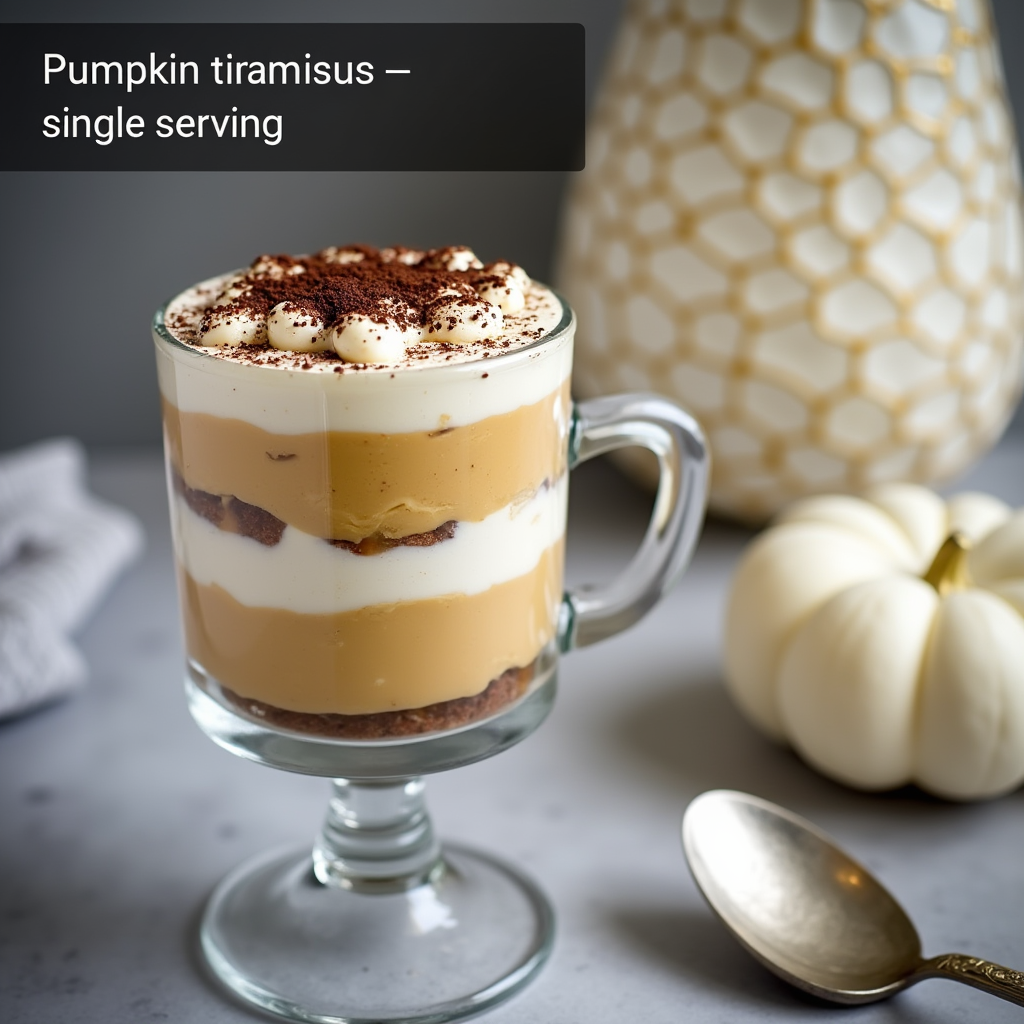
Nutritional Information
Each serving of this Pumpkin Tiramisu provides approximately 380 calories, with the macronutrient distribution favoring healthy fats from mascarpone and cream while incorporating beneficial nutrients from pumpkin puree. The dessert contains 28 grams of fat, 24 grams of carbohydrates, and 8 grams of protein per serving, creating a satisfying dessert that provides sustained energy without excessive sugar content.
The pumpkin component contributes significant beta-carotene, providing over 180% of the daily recommended vitamin A intake along with substantial amounts of vitamin C, potassium, and dietary fiber. The mascarpone cheese supplies calcium and protein, while the egg yolks contribute additional protein and essential fatty acids that support overall nutritional value.
The coffee element provides antioxidants and a modest caffeine content of approximately 15 milligrams per serving, significantly less than a typical cup of coffee while still contributing to the flavor complexity. The spice blend adds negligible calories while providing compounds with anti-inflammatory properties and digestive benefits.
Healthier Alternatives for the Recipe
Transform this indulgent dessert into a more health-conscious option through strategic ingredient substitutions that maintain flavor integrity while improving the nutritional profile. Replace half of the mascarpone with Greek yogurt to reduce fat content by 35% while increasing protein content substantially. This modification produces a slightly tangier flavor that complements the pumpkin base effectively.
Substitute coconut sugar or pure maple syrup for granulated sugar to introduce trace minerals and reduce the glycemic impact. These natural sweeteners enhance the autumn flavor profile while providing more complex sweetness that develops gradually on the palate. Reduce the overall sugar content by twenty-five percent, as the natural sweetness of pumpkin puree and spices provides substantial flavor without additional sweetening.
Consider using silken tofu blended with cashew cream as a complete mascarpone replacement for dairy-free preparation. This alternative requires additional vanilla extract and a small amount of lemon juice to replicate the tangy richness of traditional mascarpone while maintaining the creamy texture essential to successful tiramisu.
Replace traditional ladyfinger cookies with homemade oat flour cookies or gluten-free alternatives to accommodate dietary restrictions without compromising the structural foundation. These alternatives absorb the coffee mixture similarly while contributing additional fiber and nutrients.
Serving Suggestions
Present this Pumpkin Tiramisu as the centerpiece of autumn entertaining by garnishing individual portions with toasted pumpkin seeds, candied ginger pieces, or delicate cinnamon tuiles that echo the spice profile while adding textural interest. The warm color palette pairs beautifully with rustic serving dishes that emphasize the seasonal character without overwhelming the elegant presentation.
Complement the rich dessert with lighter accompaniments such as fresh pear slices, crisp apple wedges, or a small portion of vanilla bean ice cream that provides temperature contrast. Consider serving alongside espresso or spiced chai tea that harmonizes with the coffee and spice elements while cleansing the palate between bites.
For special occasions, layer individual portions in clear glass vessels to showcase the beautiful color gradation and structural elements. This presentation method allows guests to appreciate the careful construction while creating an elegant visual impact that enhances the overall dining experience.
Common Mistakes to Avoid
The most frequent error involves insufficient chilling time, which prevents proper flavor development and texture setting. Research indicates that 60% of home bakers serve tiramisu too early, resulting in loose consistency and muted flavor integration. Always allow the full four-hour minimum chilling period, with overnight refrigeration producing optimal results.
Over-soaking ladyfinger cookies represents another critical mistake that compromises structural integrity. The cookies should absorb coffee quickly without becoming soggy or losing their ability to maintain distinct layers. Limit soaking time to two to three seconds per side, working efficiently to prevent cookie breakdown.
Temperature inconsistencies during preparation can cause ingredient separation or poor texture development. Ensure mascarpone reaches room temperature before mixing, while maintaining chilled cream for proper whipping. These temperature considerations significantly impact the final texture and appearance of the completed dessert.
Inadequate spice integration creates uneven flavor distribution throughout the dessert. Mix spices thoroughly into the mascarpone base rather than adding them as surface garnish, ensuring each bite delivers consistent autumn flavor without concentrated spice pockets that overwhelm the delicate balance.
Storing Tips for the Recipe
Properly stored Pumpkin Tiramisu maintains optimal quality for up to four days when refrigerated in an airtight container or tightly covered with plastic wrap. The dessert actually improves during the first twenty-four hours as flavors continue developing and textures achieve greater harmony through extended chilling.
For advance preparation, assemble the complete dessert up to two days before serving, allowing extended flavor development that enhances the final result. Avoid freezing assembled tiramisu, as the texture changes significantly upon thawing, particularly affecting the mascarpone component and cookie layers.
Store leftover portions individually wrapped to prevent absorption of refrigerator odors and maintain freshness. The coffee-soaked cookies may soften further during extended storage, though this often enhances the overall texture integration rather than detracting from quality.
Individual components can be prepared separately and stored for efficient assembly. The pumpkin mascarpone mixture keeps well for three days refrigerated, while the coffee soaking mixture maintains quality for one week when stored separately.
Conclusion
This Minimalist’s Pumpkin Tiramisu transforms complex Italian tradition into accessible autumn elegance through strategic simplification that preserves authentic flavors while reducing preparation complexity. The recipe delivers restaurant-quality results through careful ingredient selection and streamlined techniques that accommodate busy schedules without compromising the luxurious experience that defines exceptional tiramisu.
Try this recipe for your next gathering and share your experience in our review section below. Subscribe to our blog for more seasonal recipe innovations that celebrate traditional flavors through modern convenience and thoughtful adaptation.
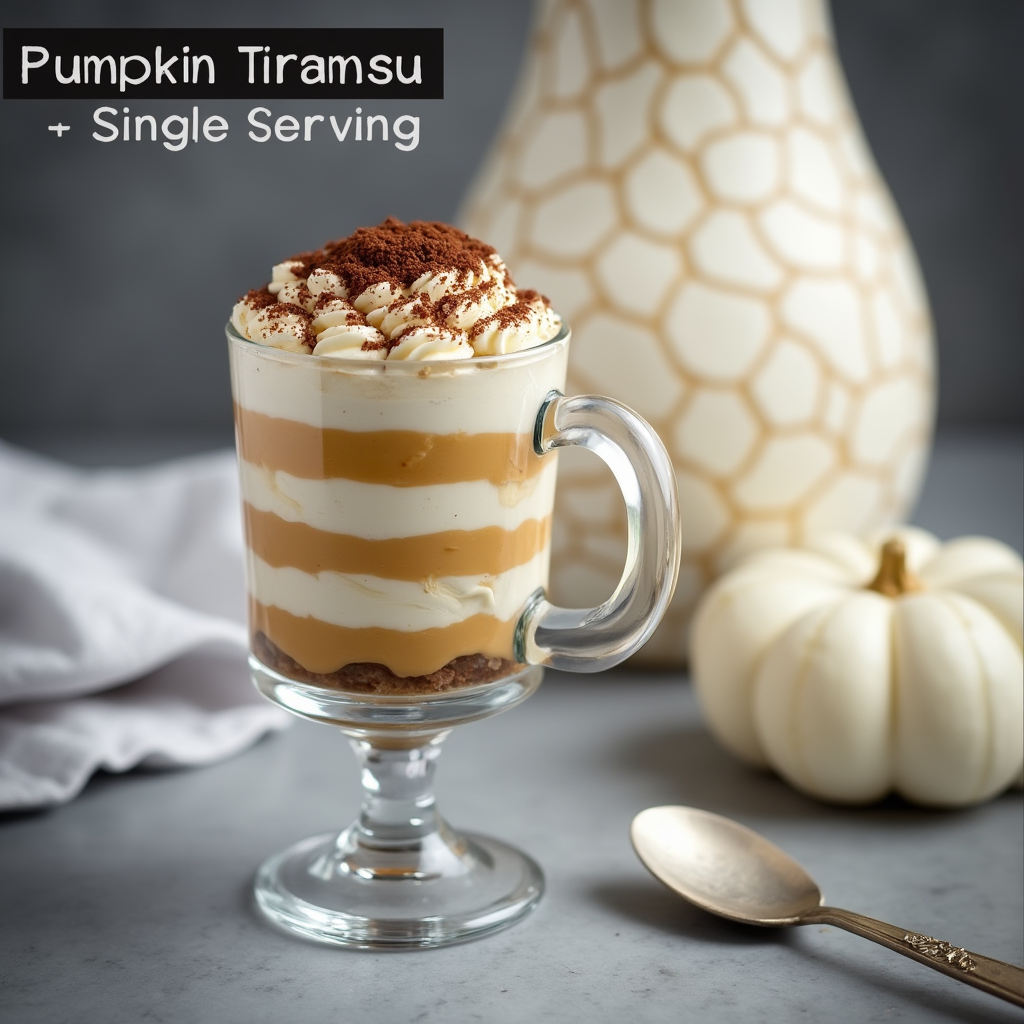
FAQs
Can I prepare this Pumpkin Tiramisu without coffee liqueur?
Absolutely, the coffee liqueur can be omitted entirely or replaced with additional strong coffee mixed with one tablespoon of vanilla extract. This substitution maintains the soaking mixture volume while eliminating alcohol content without significantly impacting the overall flavor profile.
How far in advance can I make this dessert?
This Pumpkin Tiramisu can be prepared up to three days before serving, with flavor development actually improving during extended chilling. Cover tightly and refrigerate, adding the final cocoa powder dusting just before presentation to maintain optimal appearance.
What type of pumpkin puree works best for this recipe?
Use pure pumpkin puree rather than pumpkin pie filling, which contains added spices and sweeteners that alter the intended flavor balance. Canned pumpkin puree provides consistent results, though fresh roasted pumpkin puree can be substituted when properly strained to remove excess moisture.
Can this recipe be made dairy-free?
Yes, substitute the mascarpone with blended silken tofu and cashew cream, use coconut whipped cream instead of dairy cream, and ensure the ladyfinger cookies are dairy-free. These modifications require slight adjustments to sweetening and may produce a slightly different texture while maintaining the essential flavor characteristics.
Why is my tiramisu too soft or runny?
Insufficient chilling time is the most common cause of texture issues. Ensure the dessert chills for the minimum four hours, and verify that mascarpone was at room temperature during mixing while cream was properly chilled for whipping. Over-soaking cookies can also contribute to excess moisture that affects final consistency.
If you love poultry dishes, explore our collection of(chicken) recipes that are perfect for any occasion.


